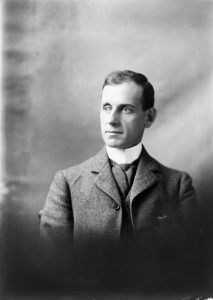1860 – 1932
A lawyer and politician, Belcourt was an ardent defender of French Canadian rights who spearheaded the legal fight against Regulation 17 in Ontario.
Belcourt lived at several addresses in Sandy Hill during his long stay in Ottawa. After a short time on Daly Ave., he moved to 415 Theodore (now Laurier Ave. E.) between 1894 and 1902 and then 489 Wilbrod St. where he lived for 16 years starting in 1903. This was also the year he married his second wife (his first wife had died in 1901). Both of these houses are now gone. In 1919, he moved to the grand Timber House at 27 Goulburn Ave. where he lived until his death.
Born in Toronto from a French Canadian father and an English Canadian mother and educated in Québec, Belcourt was fluently bilingual and moved easily between French and English society. He represented the City of Ottawa in Parliament between 1896 and 1907 and was briefly Speaker of the House of Commons in 1904. Laurier appointed him to the Senate in 1907.
A private man in poor health for much of his life, Belcourt found his voice fighting the Ontario government’s attempts to suppress French language education rights in the province. He defended the Ottawa Separate School Board’s right to continue to teach in French before the Supreme Court of Ontario, the Court of Appeal and ultimately the Judicial Committee of the Privy Council in London where he won a partial victory. He also helped mobilize public opinion against the government’s policies by writing articles and delivering speeches. He was twice president of the Association Canadienne Française d’Éducation en Ontario and also co-founded the Unity League of Ontario

to promote a greater understanding between French and English. The Toronto Globe described him as “… an able lawyer, an adroit and tactful politician, and, in his general demeanor, friendly with all and singularly free from religious or national prejudices” (quoted in Morgan, 1912). A small town in the Abitibi region of Québec is named in his honour.
Timber House, where Belcourt lived the last years of his life, has a very distinctive architecture and was built around 1902 by William Davis, who owned the even-grander house at the top of the hill on Laurier Ave., where the Strathcona Apartments now stand (see photo in Lost Sandy Hill). Over the years, the occupants of Timber House have included foreign diplomats, senior civil servants and the military. For some 60 years, the house served as offices for various industry associations (including the lumber industry, hence the name). It now features high-end apartments.
